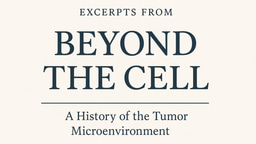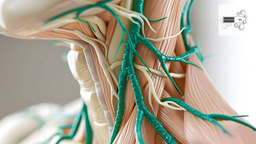The Silence of Tumors: Dormancy and the Microenvironment
Published in Cancer and Cell & Molecular Biology

Cancer is a disease defined as much by its silences as by its proliferations. In the late nineteenth century, pathologists were already puzzled by the mystery of tumors that seemed to disappear after surgery, only to reawaken decades later. Rudolf Virchow, who first linked chronic inflammation to cancer, remarked on the latency of certain lesions, though he could not explain their logic. Stephen Paget’s seed-and-soil hypothesis of 1889 suggested that malignant cells were not always destined to sprout; sometimes the soil was barren, sometimes the seed lay dormant. The enigma of tumor dormancy would become one of oncology’s most haunting riddles.
For much of the twentieth century, the field’s attention was captured by the genetics of the seed. Mutations in oncogenes and tumor suppressors offered visible answers to why cells turned malignant, but they explained little about why some cancers slept. Patients who underwent mastectomy in the 1950s sometimes relapsed not in months, but in twenty years. Melanoma could return in a scarred lymph node after a quarter-century. Prostate cancer could slumber in the bone marrow, nearly undetectable, before a sudden awakening. The genome alone could not account for these long silences.
It is here that the tumor microenvironment re-enters the narrative, not as a passive stage but as a governor of time. Fibroblasts, immune cells, and endothelial cells shape whether a tumor remains dormant or resumes growth. Angiogenesis emerged as one critical switch: without new vessels, a tumor could not exceed a millimeter in diameter. Judah Folkman’s experiments in the 1970s and 80s showed that tumors surgically implanted into corneas — a tissue without blood supply — could remain frozen in place indefinitely. Only when vascular growth was permitted did the tumor awaken. The blood supply was not merely a conduit; it was a clock.
Yet vascular silence was only part of the story. The immune system, too, acted as a custodian of dormancy. Autopsy studies in the 1990s revealed tiny, clinically undetected cancers nestled within thyroids, prostates, and breasts. Why had they not progressed? Cytotoxic T cells and natural killer cells, investigators proposed, maintained a state of equilibrium — a precarious balance between malignant growth and immune suppression. Immunoediting could sculpt tumors into silence, pruning aggressive clones while keeping the population in check. This was not eradication but coexistence: a chronic infection rather than a cure.
Even the extracellular matrix, long regarded as an inert scaffold, proved to be a timekeeper. Dense collagen, stiffened and cross-linked, created physical constraints that prevented expansion. A quiescent tumor cell could remain locked within its microenvironment, unable to break through. When remodeling occurred — through inflammation, injury, or aging — the mechanical barrier could dissolve, and dormancy could end. The soil, in Paget’s metaphor, could be tilled again.
Modern tools have given us a closer look at this silent phase. Spatial transcriptomics shows niches of dormant cells adjacent to blood vessels, wrapped by fibroblasts, patrolled by immune cells. Mathematical models of ecological balance help explain how tiny clusters persist without tipping into extinction or explosion. Clinicians, too, are beginning to recognize the implications. For breast cancer survivors, the risk of recurrence stretches for decades — a testament to how long dormancy can last. In melanoma and prostate cancer, the fear of late relapse is a reminder that the disease is never entirely past.
This knowledge raises an unsettling paradox: if dormancy is a form of survival, should we attempt to prolong it rather than end it? Angiogenesis inhibitors, for instance, may work not by killing tumors but by keeping them asleep, indefinitely forestalling progression. Immunotherapies may tilt the balance back toward equilibrium rather than cure. Even the microbiome may participate: commensal bacteria influence systemic inflammation, and by extension, the microenvironmental signals that determine whether a cell rests or divides.
The story of dormancy reframes cancer not as an inexorable march toward growth, but as a dialogue between cell and context, between seed and soil. It is a dialogue conducted in whispers — cytokines, matrix proteins, hypoxic signals — rather than in the blunt language of mutations. And it suggests that treatment may require a new philosophy. Perhaps the aim is not always eradication but containment, not war but truce.
What was once seen as an inexplicable silence is now recognized as an active negotiation, orchestrated by the tumor microenvironment. The challenge ahead is to learn how to intervene in that negotiation — to prolong stasis, to deepen equilibrium, to sustain the silence. In doing so, we may change the way we think about remission itself: not as a temporary reprieve, but as a durable state of ecological balance.
Cancer, in this telling, is not just a story of growth. It is also a story of restraint — and of the soil that teaches the seed when to sleep, and when to awaken.
Follow the Topic
Ask the Editor – Inflammation, Metastasis, Cancer Microenvironment and Tumour Immunology
Got a question for the editor about inflammation, metastasis, or tumour immunology? Ask it here!
Continue reading announcement




Please sign in or register for FREE
If you are a registered user on Research Communities by Springer Nature, please sign in
I am a cancer doc, a medical oncologist of 63 years clinical experience with my early years spent working on immune tolerance in neonatal mice and then onto hematopathology of HD (Hodgkin’s disease)- all at the University of Chicago. In 1971, I co-authored a paper:
Strum SB, Rappaport H: The persistence of Hodgkin's disease in long-term survivors. Am J Med 1971, 51(2):222-240.
In all of the patients with HD that appeared cured or at the very least were in clinical remission long-term, we found microscopic evidence of persistent HD.
I will continue this post later today. Just got called to an emergency- sorry.
Stephen B. Strum, MD, FACP
Continuation of the comment below.
That study published in 1971 involved 280 patients diagnosed at the U of Chicago btween 1931 and 1964, with 40 patients surviving ≥ 10 years.
Of the forty patients, twenty-nine have died. Eighteen of these patients· had postmortem examinations. In sixteen, histologic evidence of Hodgkin's disease was observed.
In the group of twenty-nine patients, the cause of death could be determined in twenty-one. Hodgkin's disease could be implicated as a significant contributory cause of death in fourteen. In seven patients, the cause of death could not be directly attributed to Hodgkin's disease but to causes such as disseminated breast carcinoma, malignant melanoma, coronary occlusion, enteritis, nephritis, and hepatitis secondary to radiation, pneumonia secondary to chemotherapy, and pulmonary fibrosis secondary to. radiation, and systemic coccidioidomycosis. In six of these, autopsies were performed, and in four, Hodgkin's disease was present. In the patients with systemic coccidioidomycosis and pulmonary fibrosis, no histologic evidence of Hodgkin's disease was found.
The conclusion presented in that publication from 54 years ago was that "The finding of persistent Hodgkin's disease in long-term survivors, especially in those dying from apparently unrelated causes, suggests that in some patients with Hodgkin's disease, clinical cure may in fact represent a state of equilibrium in which the host has come to terms with his disease."
My focus in oncology changed to prostate cancer in the early 1980s as a result of my collaboration with Fernand Labrie in treating metastatic disease with combination anti-androgen receptor blockade + LHRH-agonist (LHRH-A) therapy. Many of these patients went into a profound remission with a significant reduction in tumor burden based on a sustained decrease in ultrasensitive PSA levels to undetectable levels. Moreover, an appreciation of the many fuels used to sustain cancer growth allowed for interventions that were and continue to be an integrative approach to cancer patient management:
Cancer Fuels
1. High glycemic carbohydrates [check 2hr-PPBG] i.e., PPBG (post-prandial blood glucose)
2. LDL [check NMR LipoProfile] via LipoScience at http://www.lipoprofile.com/index.cfm
3. Omega 6 fatty acids [check Comprehensive Fatty Acid [CFA] profile] via Mayo Medical Labs at http://bit.ly/1AtZ7
4. Arginine, Copper [review supplements, diet]
5. Glutamates, aspartates, cysteine [review diet]
6. pro-inflammatory cytokines [check IL-1β, TNF-α, PLA2, Rx COX2 inhibitors]
7. bone-derived growth factors (BDGF) [check bone resorption markers DpD (deoxypyridinoline) on urine, CTX (C-Terminal Telopeptide, b-Crosslaps) on serum, TRAP5β only available in Europe
8. Hypoxia
9. Hypercoagulability [check coagulation panel], e.g., PT, PTT, fibrinogen, fibrin monomer, anti-thrombin III, platelet count
All of these, and likely more unidentified energy sources for the cancer cell population, became part of what was termed the SAIN (Systems Analysis & Integrity Networking) methodology in treating those with neoplastic disease. This multi-factorial view of the tumor microenvironment (TME) has allowed the prolonged survival of many men with prostate cancer. I would expect that if detailed autopsies were performed on this population, microscopic or very low tumor burdens would be found, similar to those in the HD study from 54 years ago.
Dr. Strum — thank you for sharing this remarkable perspective and history. Your 1971 study with Dr. Rappaport is a profound early demonstration of what we now call tumor dormancy: microscopic persistence even in patients who appeared clinically “cured.” The conclusion you drew then — that long-term remission may reflect a negotiated equilibrium rather than complete eradication — resonates deeply with the very questions Paget and Virchow set in motion, and it is also at the heart of my forthcoming book, Beyond the Cell, which explores how the tumor microenvironment governs cancer’s silences as much as its growth.
I’m struck by how your trajectory from Hodgkin’s disease to prostate cancer mirrors the broader shift in oncology — from focusing on the seed alone to recognizing the soil and the fuels that sustain it. Your SAIN methodology anticipates many of the modern integrative frameworks for understanding cancer as an ecological system, with multiple energy inputs and regulatory constraints.
Your comment beautifully underscores the continuity between past and present: the idea that “remission” may represent a state of containment, balance, or truce — not absence. I would love to hear more of your reflections on how today’s molecular and microenvironmental tools (spatial transcriptomics, immune profiling, metabolic assays) either confirm or challenge what you observed in the clinic decades ago.
Thank you again for taking the time to add this history. It enriches the cancer narrative immeasurably.
Nick, thanks for the kind words. I believe that scientists often get pigeonholed in their thinking. We do not see the bigger picture, and the failure to develop a broader perspective, a more comprehensive view of what seems to be reality, remains underdeveloped.
I have, for necessity's sake and the sake of what you might call "self-contentment," incorporated much philosophy into the clinical care of patients under my care. The SAIN (Systems Analysis & Integrity Networking) is an expression of the oneness of life, what we glibly call the uni-verse or one story. We scientists, more often than not, fail to see the ceaseless exchange between the biotic and the abiotic, between the breath of life and the quiet turning of stones, tides, and winds. When we introduce "commonality" into the world of the MD (medical detective), we necessarily also realize the value of methodologies that see this universality. This is why arenas such as gene expression profiling (GEP), 'omics, and technologies like OLINK should be employed in the biological assessment of our status.
Seventeen years ago, I was asked to present this approach to a group of physicians at a conference on Anti-Aging Therapeutics. I agreed to do so despite knowing that some presentations I considered unacceptable based on inadequate validation. The positive impact of my decision to present this topic was that it prompted me to put this approach into writing. I do not know if this Research Community accepts links to documents but this url allows you and others to get a more comprehensive picture of what I have used in real-world medical practice- and it works to the benefit of the patient.
https://www.dropbox.com/scl/fi/07tulwyw98zgnaahde0u9/Strum-2008-SAIN-A4M-Presentation.pdf?rlkey=ny57jaoc29vdsabgwfsfw0ttj&dl=0